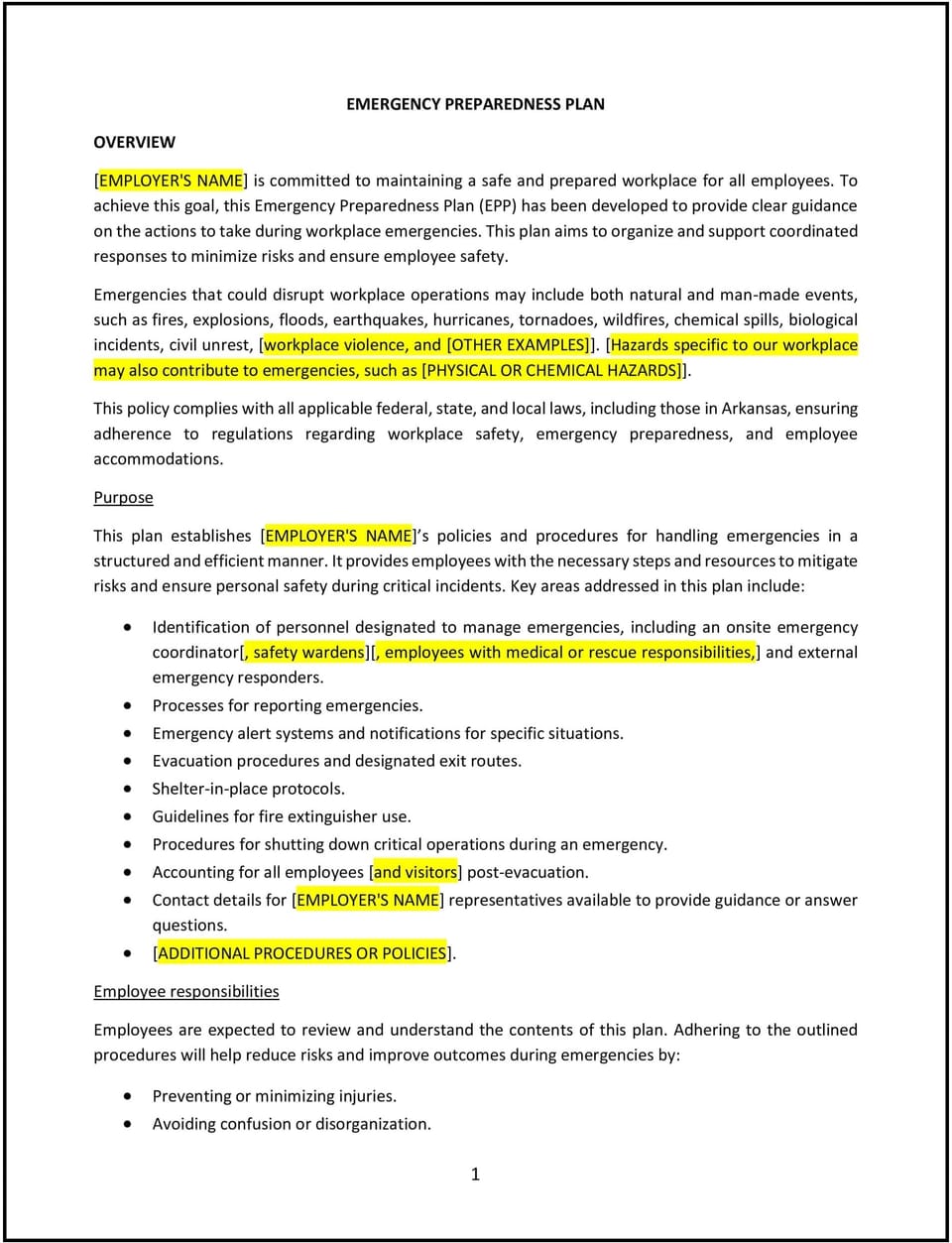Emergency preparedness plan (Arkansas): Free template

Emergency preparedness plan (Arkansas)
In Arkansas, an emergency preparedness plan provides businesses with guidelines to manage and respond effectively to emergencies, such as natural disasters, workplace accidents, or other unforeseen events. This policy ensures the safety of employees, minimizes operational disruptions, and supports compliance with relevant safety regulations.
This policy outlines the procedures for emergency response, employee responsibilities, and communication protocols. By implementing this plan, Arkansas businesses can enhance workplace safety, reduce risks, and foster a culture of preparedness.
How to use this emergency preparedness plan (Arkansas)
- Identify potential emergencies: Clearly define the types of emergencies the plan covers, such as severe weather, fire, chemical spills, or medical crises.
- Establish roles and responsibilities: Assign specific roles to employees, such as emergency coordinators or evacuation leaders, to ensure an organized response.
- Create evacuation procedures: Develop detailed evacuation routes, assembly points, and processes for accounting for all employees during an emergency.
- Implement communication protocols: Specify how employees and external parties, such as emergency services, will be notified and updated during an incident.
- Conduct training and drills: Regularly train employees on the emergency plan and hold drills to ensure readiness and familiarity with procedures.
Benefits of using this emergency preparedness plan (Arkansas)
This plan offers several advantages for Arkansas businesses:
- Enhances workplace safety: Reduces risks to employees by ensuring preparedness and effective response to emergencies.
- Minimizes operational disruptions: Helps the business recover quickly by establishing clear protocols for managing emergencies and resuming operations.
- Supports compliance: Aligns with Arkansas safety regulations and federal Occupational Safety and Health Administration (OSHA) requirements.
- Promotes employee confidence: Builds trust by demonstrating the business’s commitment to employee safety and well-being.
- Protects assets: Reduces potential damage to property, equipment, and business operations through proactive planning.
Tips for using this emergency preparedness plan (Arkansas)
- Address Arkansas-specific risks: Consider local hazards, such as tornadoes or flooding, and include relevant response strategies in the plan.
- Partner with local services: Collaborate with Arkansas emergency services, such as fire departments or disaster relief organizations, to align response efforts.
- Update contact lists: Regularly review and update emergency contact information for employees and external stakeholders.
- Provide accessibility: Ensure the plan is accessible to all employees, including those with disabilities, by providing accommodations such as accessible routes or communication methods.
- Review periodically: Update the plan as needed to reflect changes in the workplace, regulations, or potential risks.
Q: How does this plan benefit the business?
A: This plan enhances workplace safety, reduces risks to employees and assets, and ensures compliance with Arkansas and federal safety regulations.
Q: What types of emergencies does the plan cover?
A: The plan covers emergencies such as severe weather, fires, chemical spills, medical crises, and any other incidents relevant to the business’s operations.
Q: How does this plan support compliance with Arkansas laws?
A: The plan aligns with state safety regulations and OSHA requirements, ensuring the business meets its legal obligations for emergency preparedness.
Q: What steps should the business take to ensure employee readiness?
A: The business should conduct regular training, hold emergency drills, and communicate the plan clearly to all employees to ensure preparedness.
Q: How can the business keep the plan up to date?
A: The business should review the plan periodically, incorporate feedback from drills or actual incidents, and update it to reflect changes in workplace conditions or regulations.
This article contains general legal information and does not contain legal advice. Cobrief is not a law firm or a substitute for an attorney or law firm. The law is complex and changes often. For legal advice, please ask a lawyer.


